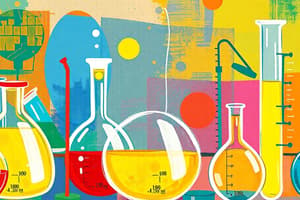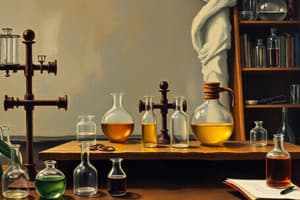Podcast
Questions and Answers
What is a beaker?
What is a beaker?
- A tool for heating liquids
- An open cylindrical container with a pouring lip (correct)
- Used for precise measurements
- A closed cylindrical container
What instrument is used to measure the volume of a liquid?
What instrument is used to measure the volume of a liquid?
Graduated cylinder
What is the function of a buret?
What is the function of a buret?
To measure precisely how much liquid is used in titration.
Describe a magnetic stir bar.
Describe a magnetic stir bar.
What is the function of a clamp in a laboratory?
What is the function of a clamp in a laboratory?
What does a ring stand do?
What does a ring stand do?
What is a spot plate used for?
What is a spot plate used for?
What is the purpose of a test tube?
What is the purpose of a test tube?
How is a stir rod used?
How is a stir rod used?
What does a vial contain?
What does a vial contain?
What is the function of a syringe?
What is the function of a syringe?
What are the safety precautions for Bunsen burner usage?
What are the safety precautions for Bunsen burner usage?
What should you do in the case of a chemical spill?
What should you do in the case of a chemical spill?
Eye protection must be worn in the lab whenever lab is in session.
Eye protection must be worn in the lab whenever lab is in session.
What does 'MSDS' stand for?
What does 'MSDS' stand for?
What is the formula for density?
What is the formula for density?
What is the strongest bond type?
What is the strongest bond type?
What happens during sublimation?
What happens during sublimation?
The weakest intermolecular forces are called _____ forces.
The weakest intermolecular forces are called _____ forces.
Flashcards are hidden until you start studying
Study Notes
Laboratory Equipment
- Beaker: Open cylindrical container for mixing larger amounts of substances; not for precise measurements.
- Graduated Cylinder: Instrument for accurately measuring liquid volumes.
- Buret: Precision device for measuring liquid amounts during titration.
- Magnetic Stir Bar: Teflon-covered magnet for stirring solutions using a stir motor.
- Clamp: Surgical tool to compress blood vessels or close intestions.
- Ring Stand: Supports funnels and wire gauze above the table.
- Spot Plate: Flat plate with "wells" used for small tests like mini test tubes.
- Test Tube: Open tube for holding liquids.
- Stir Rod: Glass tool used for mixing substances.
- Vial: Small container for holding medicine or liquids.
- Syringe: Medical device for injecting or withdrawing fluids.
Safety Precautions
- Bunsen Burner Safety: Keep gas off when not in use, monitor during operation, and avoid flammable substances.
- Chemical Safety: Dispose of hazardous waste in designated containers; keep concentrated acids in fume hoods.
- Centrifuge Use: Never place your hand in a moving rotor and balance liquid amounts in vials.
- Balance Use: Always tare the balance before measuring; use a spatula for transferring materials.
Chemical Concepts
- Thermodynamics: ΔG = ΔH - TΔS; signs indicate endothermic or exothermic reactions.
- Acid/Base Relationships: pH and hydronium ion relationships defined by pH = -log[H+].
- Redox Reactions: Reducing agent oxidizes while the oxidizing agent reduces; uses mnemonic "leO the lion says GeR".
- Intermolecular Forces: Attraction between molecules includes hydrogen bonds, dipole-dipole interactions, and dispersion forces.
Matter and Phase Changes
- Sublimation: Transition from solid to gas.
- Condensation: Process of gas to liquid.
- Fusion: Melting process.
- Dynamic Equilibrium: The rates of dissolution and deposition are equal.
Measurement Concepts
- Density: Defined as mass per unit volume.
- Percent Error: [observed - accepted] / accepted × 100%.
- Significant Figures: Rules for counting significant digits in measurements include non-zero digits and zeros between non-zero digits.
Graphing and Relationships
- Graphing: Essentials include a title, labeled axes, and a best-fit line.
- Directly vs. Inversely Related Variables: Variables can have linear (direct) or hyperbolic (inverse) relationships.
- Interpolation and Extrapolation: Methods of estimating values within or outside experimentally determined data ranges.
Laboratory Protocols
- MSDS Access: Safety data sheets available online and in laboratory.
- Fire Safety: Evacuate through alternative routes if blocked by fire.
- Eye Protection: Required whenever labs are in session; goggles should provide full coverage.
- Spillage Protocol: Inform instructor and follow cleanup procedures for spills.
Studying That Suits You
Use AI to generate personalized quizzes and flashcards to suit your learning preferences.





